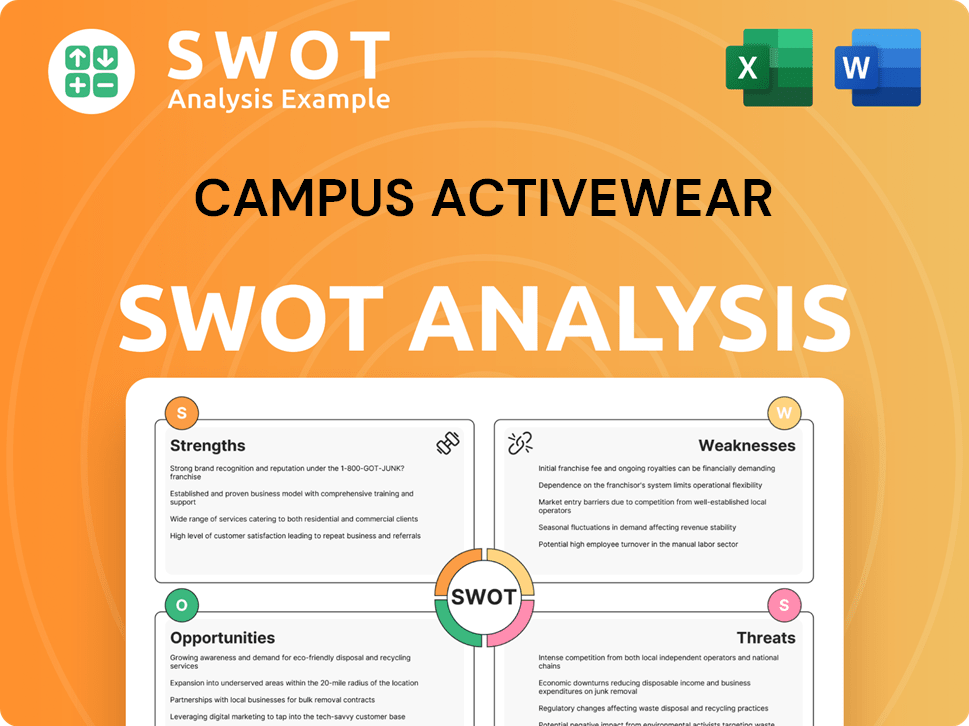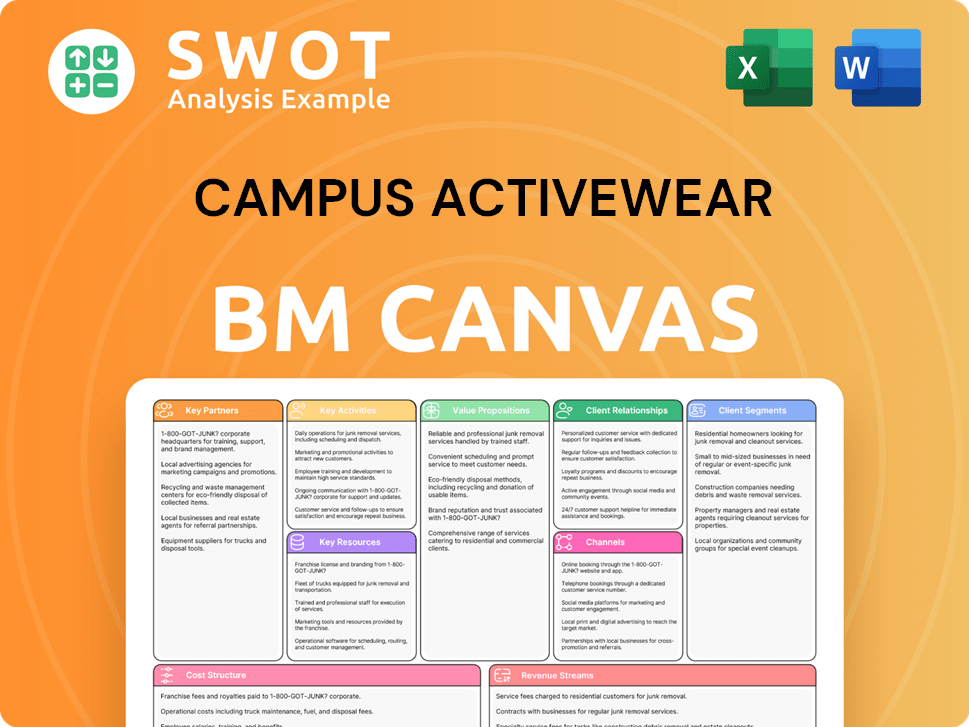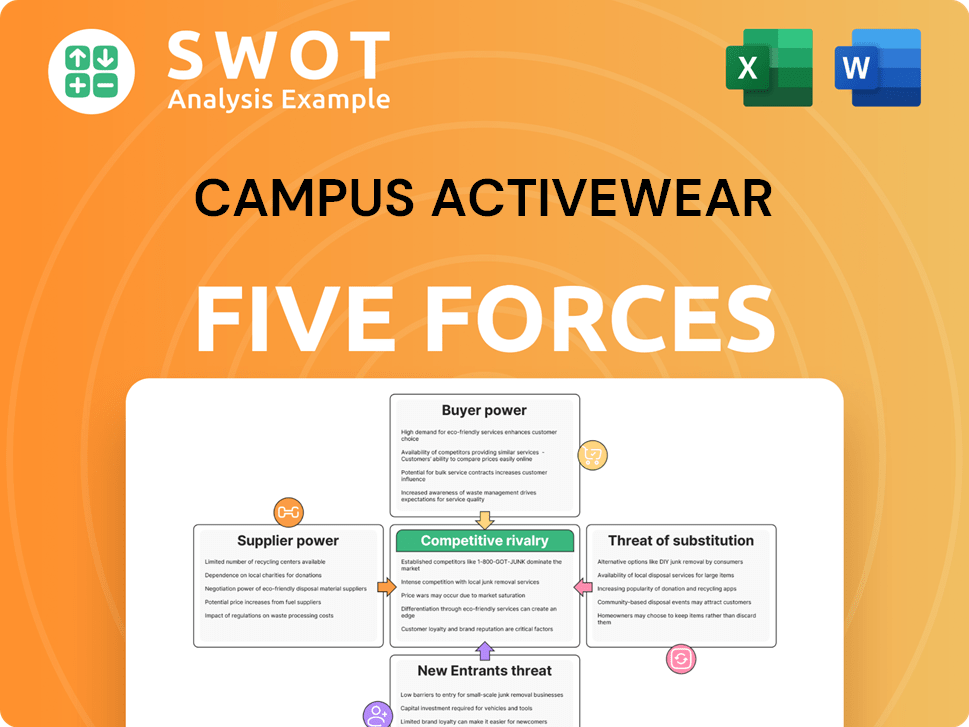Campus Activewear Bundle
How Did Campus Activewear Conquer the Indian Footwear Market?
Discover the dynamic sales and marketing strategies that propelled Campus Activewear from a local manufacturer to a leading force in India's booming sports and athleisure market. This analysis delves into how Campus Activewear, a homegrown brand, masterfully crafted its Campus Activewear SWOT Analysis, transforming its approach to reach a wider consumer base. Learn how they navigated the competitive landscape, leveraging innovative tactics to capture significant market share.

From its humble beginnings, Campus Activewear's journey showcases a remarkable evolution in branding and distribution. This exploration will uncover the intricacies of its sales and marketing plan, including its digital marketing tactics and customer acquisition methods. We'll examine the company's strategic decisions, from its initial focus on Tier 2 and Tier 3 cities to its current omni-channel presence, revealing how Campus Activewear effectively reaches customers and maintains its strong brand positioning within the Campus Activewear Market.
How Does Campus Activewear Reach Its Customers?
The sales and marketing strategy of Campus Activewear centers on a robust omnichannel approach, ensuring it connects with consumers through diverse channels. This strategy includes a strong presence both online and offline, allowing the brand to cater to a wide range of customer preferences and shopping behaviors. The integration of various distribution channels is a key element of their overall strategy.
Campus Activewear's distribution network strategically combines physical retail locations with a strong digital presence. This approach enables the company to reach a broad audience across different geographies and demographics. By leveraging both established and emerging sales channels, Campus Activewear aims to maximize its market reach and sales performance.
The company's sales strategy is designed to enhance brand visibility and drive sales growth. The strategy focuses on expanding its distribution network, improving its online presence, and introducing innovative marketing campaigns. This comprehensive approach supports the company's goal of becoming a leading player in the footwear market.
Offline, Campus Activewear has a vast network. As of October 2024, it includes over 20,000 geo-tagged retail touchpoints and approximately 296 exclusive brand outlets (EBOs) across over 650 cities in 28 states. These EBOs operate under COCO and FOFO models.
Online, Campus Activewear has a strong presence on major e-commerce platforms like Flipkart, Amazon, and Myntra. The company also operates its own D2C website. Revenue through its owned e-commerce platforms grew at a CAGR of 140% between FY19 and FY23.
The company utilizes a multi-channel distribution strategy. This includes exclusive brand outlets (EBOs), large format stores (LFS), and a robust e-commerce presence. The trade channel is used for volumes, while online marketplaces and EBOs offer a wider range of products.
Campus Activewear has been an early adopter of quick-commerce platforms such as Blinkit and Zepto for instant delivery. This strategy helps unlock new consumer bases and accelerates portfolio premiumization. In FY23, 7.9 million pairs of shoes were sold through online channels, with over 7 million pairs sold online in FY24 alone.
Campus Activewear's sales strategy focuses on a comprehensive omnichannel approach, balancing online and offline channels. The company's distribution network is extensive, including EBOs, LFS, and e-commerce platforms. This strategy supports the brand's growth and market penetration, as also outlined in the Growth Strategy of Campus Activewear.
- Extensive retail network with over 20,000 touchpoints.
- Strong presence on major e-commerce platforms and its own D2C website.
- Early adoption of quick-commerce platforms for instant delivery.
- Strategic shift towards a 65-70% FOFO and 30-35% COCO ratio for new EBO additions.
Campus Activewear SWOT Analysis
- Complete SWOT Breakdown
- Fully Customizable
- Editable in Excel & Word
- Professional Formatting
- Investor-Ready Format

What Marketing Tactics Does Campus Activewear Use?
The company's marketing strategy is a blend of digital and traditional methods, designed to boost brand awareness and drive sales. This approach has shifted from trade-led marketing to a consumer-focused strategy. The company has increased its advertising and promotion (A&P) spending significantly.
The company's strategy involves a data-driven approach, using big data analytics to understand consumer preferences and personalize shopping experiences. They also focus on product innovation, with a quick turnaround from concept to launch, helping them stay ahead of trends. This comprehensive approach aims to engage customers across multiple touchpoints.
The company's marketing tactics include a variety of digital strategies, such as content marketing, SEO, and social media engagement. They actively collaborate with celebrities and influencers to connect with their target demographic. The company also utilizes traditional methods like television advertising and in-store branding to reach a wider audience. This integrated approach aims to build a strong brand presence and drive sales growth.
The company uses content marketing, SEO, and paid advertising to boost online visibility. They also employ email marketing and partnerships with influencers. Their strong social media presence helps them connect with their target audience.
Collaborations with celebrities and influencers, like King and Sonam Bajwa, are used to increase brand visibility. The 'Move with Swag' campaign is a key example of this strategy. They also engage with micro-influencers to enhance relatability.
They use big data analytics to track consumer preferences. Advanced algorithms are employed to personalize shopping experiences on their e-commerce platforms. This includes optimizing their mobile site and developing an app with augmented reality features.
The company uses television advertising and in-store branding to engage consumers. Their marketing mix has evolved to a full-funnel approach. This ensures engagement across various touchpoints.
The company launches a high number of new designs to keep offerings trendy. Between FY19 and FY23, over 2,800 new designs were launched. The product cycle from concept to launch is managed within 120 to 180 days.
The company has increased its A&P spending by 200 basis points. This increase brings A&P spending to 6-6.5% of sales. Pre-Covid levels were at 4-4.5%.
The company's marketing strategy is multi-faceted, focusing on digital and traditional channels to reach its target audience. This includes a strong emphasis on data analysis and product innovation to stay competitive in the market. For more details, see the Growth Strategy of Campus Activewear.
- Employs digital marketing tactics such as SEO, content marketing, and social media engagement.
- Utilizes influencer partnerships and celebrity endorsements to enhance brand visibility.
- Focuses on data-driven marketing to personalize customer experiences.
- Maintains a strong presence through traditional media like television advertising.
- Prioritizes product innovation with rapid design and launch cycles.
Campus Activewear PESTLE Analysis
- Covers All 6 PESTLE Categories
- No Research Needed – Save Hours of Work
- Built by Experts, Trusted by Consultants
- Instant Download, Ready to Use
- 100% Editable, Fully Customizable

How Is Campus Activewear Positioned in the Market?
The brand positioning of Campus Activewear centers on being a style and fashion-forward brand. It offers trendy, high-quality, and functional sports and athleisure footwear. This is achieved at affordable prices, making it accessible to the growing aspirational demands of the Indian middle class, millennials, and Gen Z.
The core message revolves around empowering individuals to express their unique identities through refined design. It seamlessly integrates elevated aesthetics with functional innovation. Campus differentiates itself from competitors, particularly international brands, by targeting the value and mid-premium price segments.
Campus Activewear's strategy focuses on innovation and technology in product development. They incorporate features like Dual-Capsule, Air-Suspension, and Foam Lite. The brand aims to cater to approximately 85% of the addressable market in the sports and athleisure footwear segment.
Campus offers high-quality footwear at accessible price points. This strategy appeals to the aspirational demands of the Indian middle class. It also targets millennials and Gen Z consumers, making it a key element of their overall sales and marketing plan.
The brand emphasizes refined design, integrating elevated aesthetics with functional innovation. They continuously introduce new designs, with around 300 new designs launched in FY22-23. This focus is critical for their marketing campaign examples.
Campus Activewear's target audience includes the Indian middle class, millennials, and Gen Z. This demographic is drawn to the brand's blend of style, quality, and affordability. Understanding this audience is key to how Campus Activewear reaches customers.
Campus differentiates itself by targeting the value and mid-premium price segments. This approach allows it to compete effectively with both domestic and international brands. For more insights, see the Competitors Landscape of Campus Activewear.
Campus Activewear's marketing strategy includes a focus on consistent branding across all channels. They offer a unified 'phygital' experience. The brand maintains a strong market share of 17% in the branded sports and athleisure footwear market in FY23.
- Continuous product innovation with new designs.
- Expansion into new categories like women's and children's footwear.
- Emphasis on technology and features for enhanced comfort and performance.
- Strategic pricing to maintain affordability and market competitiveness.
Campus Activewear Business Model Canvas
- Complete 9-Block Business Model Canvas
- Effortlessly Communicate Your Business Strategy
- Investor-Ready BMC Format
- 100% Editable and Customizable
- Clear and Structured Layout

What Are Campus Activewear’s Most Notable Campaigns?
The Campus Activewear Sales Strategy and marketing efforts are significantly shaped by its key campaigns. These initiatives are designed to boost brand visibility, connect with the target audience, and drive sales. The company strategically uses various marketing channels and celebrity endorsements to achieve its objectives within the competitive footwear market.
One of the most recent and impactful campaigns is the 'Move with Swag' initiative, launched in late 2023. This campaign reflects the company's commitment to positioning itself as a fashion-forward brand. The 'Move with Swag' campaign effectively showcases the brand's diverse product range and its appeal to a younger demographic.
The company's approach involves a blend of digital campaigns and product innovation. Initiatives include launching new styles and increasing spending on advertising and promotions (A&P) to strengthen its brand presence. This strategy is crucial for maintaining and expanding its market share.
The 'Move with Swag' campaign, launched in late 2023, aimed to establish the brand as a fashion-focused footwear choice. It featured hip-hop artist King and actress Sonam Bajwa. The campaign highlighted the brand's versatile footwear collections, including Campus OGs, Nitrofly, Nitroboost, and Air Capsule.
Historically, the company has utilized celebrity endorsements to enhance brand appeal. Bollywood actor Varun Dhawan was a brand ambassador during its expansion phase between 2011 and 2020. These collaborations have been instrumental in increasing brand visibility and credibility.
The company is focused on product innovation. In Q2 FY25, it launched 87 new styles, with sneakers comprising 30% of the new launches. The sneaker portfolio is projected to grow by 150% in FY25, reflecting a significant focus on this category.
The company is increasing its advertising and promotion (A&P) spending to strengthen its brand presence. This investment is crucial for supporting marketing campaigns and reaching the target audience effectively. This spending supports the overall
Campus Activewear Porter's Five Forces Analysis
- Covers All 5 Competitive Forces in Detail
- Structured for Consultants, Students, and Founders
- 100% Editable in Microsoft Word & Excel
- Instant Digital Download – Use Immediately
- Compatible with Mac & PC – Fully Unlocked

Related Blogs
- What are Mission Vision & Core Values of Campus Activewear Company?
- What is Competitive Landscape of Campus Activewear Company?
- What is Growth Strategy and Future Prospects of Campus Activewear Company?
- How Does Campus Activewear Company Work?
- What is Brief History of Campus Activewear Company?
- Who Owns Campus Activewear Company?
- What is Customer Demographics and Target Market of Campus Activewear Company?
Disclaimer
All information, articles, and product details provided on this website are for general informational and educational purposes only. We do not claim any ownership over, nor do we intend to infringe upon, any trademarks, copyrights, logos, brand names, or other intellectual property mentioned or depicted on this site. Such intellectual property remains the property of its respective owners, and any references here are made solely for identification or informational purposes, without implying any affiliation, endorsement, or partnership.
We make no representations or warranties, express or implied, regarding the accuracy, completeness, or suitability of any content or products presented. Nothing on this website should be construed as legal, tax, investment, financial, medical, or other professional advice. In addition, no part of this site—including articles or product references—constitutes a solicitation, recommendation, endorsement, advertisement, or offer to buy or sell any securities, franchises, or other financial instruments, particularly in jurisdictions where such activity would be unlawful.
All content is of a general nature and may not address the specific circumstances of any individual or entity. It is not a substitute for professional advice or services. Any actions you take based on the information provided here are strictly at your own risk. You accept full responsibility for any decisions or outcomes arising from your use of this website and agree to release us from any liability in connection with your use of, or reliance upon, the content or products found herein.